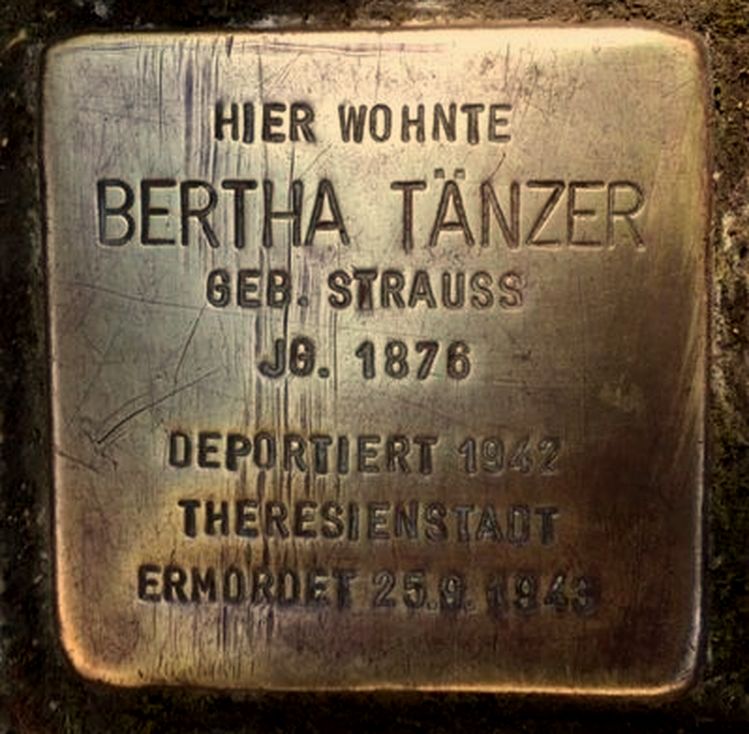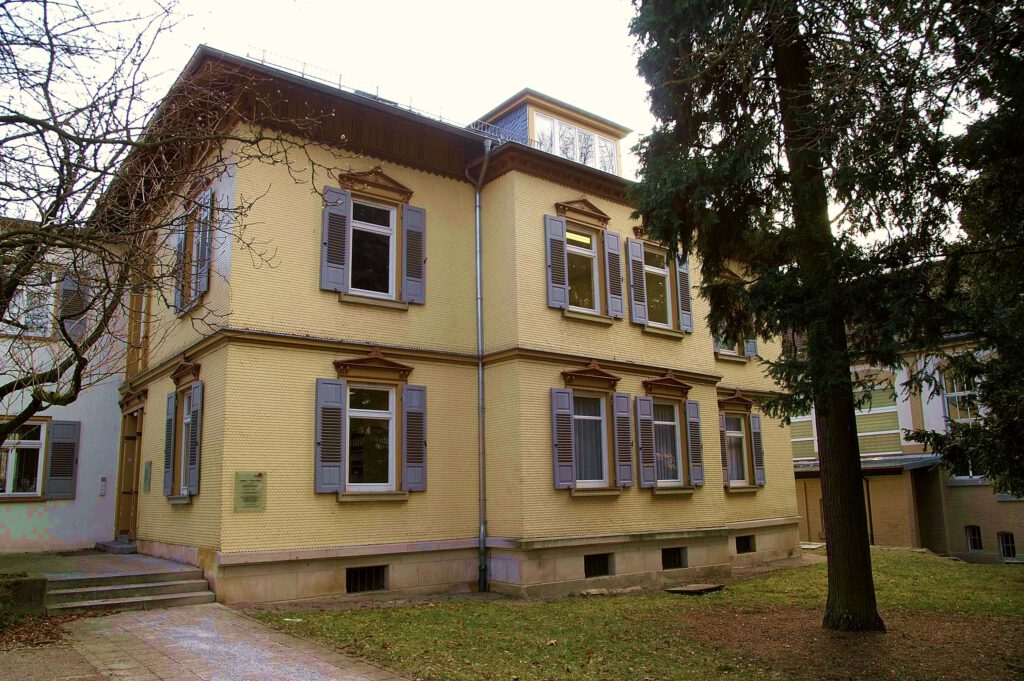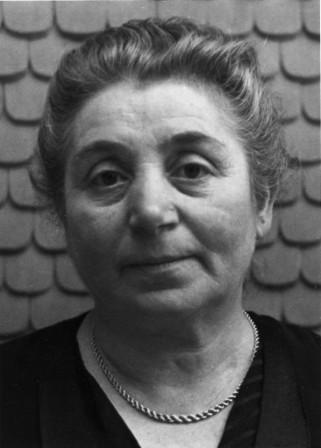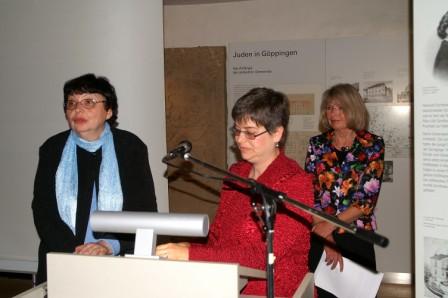Freihofstr. 46

Bertha Tänzer, née Strauss (April 14, 1876 – September 25, 1943) grew up in Merchingen in the Odenwald. In 1913 she married Rabbi Dr. Aron Tänzer from Göppingen. During their marriage she would stand at the side of an important man who was outstanding as a clergyman, scientist, translator and man of letters. He was responsible for the founding of the first lending library in Göppingen. Dr. Tänzer was a widower. Bertha was responsible for the four children of his first marriage. Together they had two more children, Erwin was born in 1914, Ilse in 1915.

The Tänzers, a family of eight, lived on the upper floors of the rabbi’s house next to the synagogue. During World War I Dr. Tänzer served at the Eastern front from August 1915 to November 1918. To serve his fatherland Germany during the First World War had been self-evident for him. Still he experienced little appreciation for it. Dr. Tänzer fought until 1936 against the defamation of Jewish Germans who were accused of having been cowardly and devious during the war. He died on February 26, 1937. Only very few Christians participated in the funeral procession of the man who had done so much for the city of Göppingen and its citizens of all faiths. An important legacy of Dr. Aron Tänzer is his ‘Geschichte der Juden in Jebenhausen und Göppingen’, published in 1927.

After the death of her husband Bertha Tänzer wrote 257 letters to her children Erwin and Ilse. They had been able to flee from Germany like their step siblings and lived abroad. In her letters she confirmed regularly: “I am healthy.” Only rarely did she mention her emotional state, as she did on October 16, 1938: “…but I feel lonely and miss you both, and also your dearly departed father. But one has to be glad that you children got out, and that your father did not have to live during these difficult times… Because this is no longer a place for young people to live, it is getting WORSE AND WORSE.”
In her letters she tried with motherly care to take part of her children’s lives. She was proud of them and of the careers they had. Erwin had found employment as an engineer in America, Ilse had received a scholarship at the ‘Royal College’ in London. Since the end of 1937 Mrs. Tänzer lived at ‘Wilhelmsruhe’, a Jewish retirement home in Sontheim, where her sister Emilie Adler also had a room. Her brother Max Strauss and his family lived in nearby Heilbronn, therefore the three siblings could support and help each other. Mrs. Tänzer considered the dignified and protected atmosphere of the home as shelter from “the cruel world outside… I thank God that you are able to live as persons of equal value with the other people around you, and that you can live as human beings…,” she wrote to Erwin in April 1938.
But Bertha Tänzer’s concerns were not limited only to the lives of her children. Due to constant correspondence with friends and acquaintances in Göppingen she learned of the business closings through ‘Aryanization’ that were taking place, as well about the emigration attempts and problems of her fellow Jewish citizens. Mrs. Tänzer used her contacts and wrote letters to relatives and friends in order to establish connections abroad. When her nephew Erich Strauss and his wife happened to get tickets for passage on a ship to Bolivia but did not have the ‘up-front money’, a required fixed amount, she appealed urgently to relatives in America to provide the necessary money. Her request was honored, and when the money arrived from the USA she expressed her thanks with the following words: “We will not perish as long as our family is willing and able to help one another.”
She described the events that befell the Jewish community in Germany on the night of November 9-10, 1938, as a ‘catastrophe’. After it became known abroad what had happened during the Pogrom Night, Erwin acted immediately. On December 4, Bertha Tänzer already received a large envelope containing sponsorship papers for her and her sister. What was Mrs. Tänzer’s reaction?
“I was speechless, Aunt Emilie cried with joy, and I?! I did not know if I should laugh or cry. I felt as if the ground had been pulled out from under me… It’s been a year since I left Göppingen… I was glad to finally have found a place where I can live in peace after all the unrest, worries and sorrow, independent from my children, not being a burden to anyone. – Now everything, everything is suddenly changing?! Don’t think that I am not grateful, dear Erwin, it is the whole upheaval, all the shocks of the last few weeks. All the ideals have collapsed, ‘Faith + Homeland.’ I will now be 63 years old. My parents, grandparents and great-grandparents have lived here, were respected, highly regarded and were awarded the highest honors… and your dear father was an ardent admirer of Germany. … You children are scattered in different countries, I am alone here and wanted to stay where my roots are.” She wanted to wait, “…to see how the conditions here will develop; everything is still so new; maybe I will know more.” She thanked him for his love and care and brought up the argument which she would repeat again and again during the following months:
“Erwin, have you considered what it will mean for you to have your mother come to stay with you?! – It will mean that you will have to take on a huge obligation and responsibility, it will be a conversion for you; until now you have been on your own, could do as you pleased without having to take someone else into consideration, and were free and independent, as I am here also. Until now I have been able to live on my pension, and if I were to come to you, you would have to support both of us…”
It was unbearable for her to think that she would become a burden for her youngest son. Her daughter Ilse also tried everything she could and sent a permit-document from the British Consulate to her mother which would have allowed her to apply for a visiting visa for England. But Mrs. Tänzer argued: “As much as I would like to be with you … I am independent here, on my own and not a burden to anyone.” The worst thing for her was that Erwin would have to support her, whether she would go to America or England. Ilse was a foreign student whose legal and financial circumstances were not assured. In addition she did not want to leave “…because I do not want to leave my brother and his family behind in dire circumstances.” Bertha Tänzer had supported the Strauss family financially since the Pogrom Night. She asked for a delay to make her decision. In the summer of 1939, Mrs. Tänzer appeared exhausted and drained when she wrote to Ilse: “If I am in danger, I will not be able to get out. It takes months to get everything ready for emigration, and I just do not have the energy to take care of it all by myself.”

On September 1, 1939, the Second World War started and the border between Germany and England were closed. Fate had made the decision for Bertha Tänzer. She could no longer travel to her daughter; she had to remain in Germany. On the Jewish New Year she wrote to her: “I cannot look backwards, because then I would reproach myself for not having followed your filial advice.”
Since November 1938 the number of inhabitants at the state home ‘Wilhelmsruhe’ had steadily increased, and Mrs. Tänzer had to share a room with her sister. Older Jewish residents from Heilbronn were forced to give up their apartments and to re-settle in the state home. Despite the adversities and misery of her surroundings, Bertha Tänzer described happy events during her life in her letters. She built a wall of resistance against the gloom of her world with these positive thoughts.
At the end of 1940 the deportations began. Her brother-in-law, Lehman Mayer, was the first victim of the racial fanaticism of the Nazis; he did not survive the hardships of ‘Camp de Gurs.’ It was a consolation for her to know that ‘death was salvation’ for him. But his fate had also shown her that she might also become a victim of the terror regime of the “Dritte Reich”. In November 1940, the “Wilhelmsruhe” Home was confiscated by the “Volksdeutsche Mittelstelle” [Ethnic German Intermediate Office]. 150 to 160 mostly elderly people were put on the street. Mrs. Tänzer and Mrs. Adler were given shelter by their brother Max Strauss in Heilbronn. It was her wish that: “Now may God grant that we can live here in tranquility and peace.” She herself had been forced to face the fact of how her life depended on external arbitrary forces. After what had happened to Lehman the thought that “the same fate … could be in store for me,” was with her continuously.
The three siblings lived until March 1942 in the so-called ‘Jewish house’ at her brother Max in Heilbronn. Mrs. Tänzer’s opinion on the subject of emigration to America now changed due to their living conditions and uncertainty. In January 1941 she wrote cautiously in a letter to Erwin: “…I also would now be happy if I could go there soon.” New provisions had been put in place that would benefit them: Starting in March 1941 children living in the USA could request visas for their parents, regardless of the quota system. She then clarified her request: “If you are now in a position to have me come to you, I want to ask you to act as quickly as possible.… I would have rather spared you, I did not want to be a burden to you children, but I now can no longer take that into consideration.” Erwin made every possible effort, sent new sponsorship documents, paid the required fees and for the ship’s passage. Mrs. Tänzer submitted the papers for approval to the ‘Jewish Emigration Office’ in Stuttgart. She waited hopefully for a positive reply. However, in June 1941 the U.S. government closed the American consulate because of recent submarine incidents. Bertha Tänzer’s and Aunt Emilie’s papers remained unprocessed at the consulate. She wrote: “We now have little or no prospect for emigration. We are very depressed, but we are consoled because many others are in the same position as we are.” She confirmed to her son: “…but it may be reassuring to you in the future that you have done everything humanly possible to make it possible for me to come to you. At any rate, I am proud and happy that I have such a good son to me.” In a letter of October 1941 she implored him to finance her emigration through the intermediate transit country of Cuba because “urgent help is necessary.” She closed her letter with the same words she usually used in her letters: “Dearest greetings from you mother.”
This would be her last letter to Erwin. Five months later she, her sister Emilie, her brother Max and his wife Hermine and his mother-in-law would be forced to re-settle in Haigerloch. On August 3, 1942, Mrs. Tänzer sent a last sign of life in the form of a postcard to her children. With the sentence “on August 18th, the most heartfelt blessings” she gave them coded information about the date of her deportation. On August 19, 1942, she was taken to the Haigerloch railroad depot, together with 135 other elderly people. Bertha Tänzer was 66 years old at that time. She and her siblings were crammed into railroad wagon and were transported with 1200 other people into the inferno. Two messages about Bertha Tänzer would be sent from Theresienstadt in 1943. On the second postcard in December 1943 her brother Max wrote that his sister Bertha Tänzer had died on September 25. She had starved to death due to the miserable living conditions. Her corpse was cremated and the ashes were thrown into the Eger river. Sixty years later her son Erwin would still be haunted wondering what was really hidden behind the words “We are healthy.”
Bertha’s sister Emilie Adler had already died during the previous year at Theresienstadt concentration camp; the life of her brother Max Strauss ended in June 1944 at the same place of horror. In October 1944 his wife Hermine was taken from Theresienstadt to the extermination camp Auschwitz and murdered there.
In April 2007 a Stumbling Stone has been laid in front of the building at Freihof Street 46, the ‘Aron-Tänzer-House’. Bertha’s granddaughter Helen Lott, who came from New York, participated in the ceremony.

(in the back Claudia Liebenau-Meyer)
(January 31, 2018 clm/ir)


Leave a Reply